There’s no shortage of SEO advice on how to rank higher for key terms. Create high-quality content. Have an effective distribution strategy. Optimize your on-page SEO. Yet, even today, acquiring high-quality backlinks is still one of the most effective components of a successful SEO strategy. But what does it take to do it right?
In this article, we’ll look at what the link gap is, how to effectively close it, and the keys to outrank your competition through your link building efforts.
Table of contents
Is investing in a link-building strategy worth the effort?
In most cases, yes.
One study by Moz has shown that brands that don’t do link building have significantly lower chances of ranking high in Google. 99% of the top 50 Google results had at least one backlink to their website.
Another Moz study, makes the strong case that the nature and the quality of links matter too. In other words, the authority of the linking site or page can significantly impact your position in SERPs. Paying for a bunch of low quality links is not a winning strategy.
While backlinks are important, they aren’t the only thing that matters when working rank higher, even if they are coming from a super-authoritative website.
Through my work, I’ve seen dozens of situations where a site built tons of valuable links, but it didn’t help it rank higher. Investigating further, I found that the most common scenario was the lack of meaningful content backed up by well-delivered keyword research.
First and foremost, your content needs to be written to rank for key search terms. Without that foundation, backlinks really won’t move the needle.
In addition to that, the responsiveness of your website is also an important ranking factor. If your website doesn’t display properly on every device, isn’t protected by HTTPS protocol, and loads very slowly, don’t be surprised if your link building efforts don’t work out.
Links are extremely important for ranking higher in SERPs, but you shouldn’t disregard the rest of the ranking factors as well. Don’t make the mistake of investing in an expensive and time consuming link building strategy without getting the basics right first.
What is the backlink gap?
The backlink gap is a difference in the number of referring domains that you have vs. that your competition has already acquired.
In practice, however, the link gap formula isn’t as straightforward because not all links are created equal.
When calculating the link gap, you should consider only the links that are valuable, not ones from sites with a low DR.
To better illustrate my point, on the screenshot below, I used Ahrefs’ Domain Comparison report to run a quick analysis:
You can see that my website is doing quite well since our DR is nearly as high as Page One Power’s, which as one of the oldest link building agencies is a competitor.
However, if we look at the number of referring domains, you’ll see that, Digital Olympus, has about half the referring domains of Page One Power.
Why then, do we have such a difference in referring domains while our DRs are nearly the same?
The answer is quite obvious—not all links that Page One Power has built are considered valuable. If we take a closer look at Page One Power’s link profile, we’ll see that the majority of referring domains are low quality.
To calculate the link gap, your focus should be on the number of meaningful links. The easiest way to get that number is by evaluating the DR of each referring domain. You can do it via Ahrefs’ Referring Domains report, which shows you the number of all referring domains. Other SEO tools such as SemRush have similar features.
At this point, filter the results from the highest to the lowest DR (for me, the minimal DR is 30):
Once you have a list of websites and their DR, you need to export the results and see how many links the top-quality (DR > 70), medium-quality (DR ≥ 30), and low-quality websites (DR < 30) have:

Here’s a side-by-side backlink profile comparison of Page One Power and Digital Olympus and the link gap we have for each link type:

In the screenshot above, you can see what I’ve been talking about a bit earlier – the link gap between Page One Power and Digital Olympus is significant, while our DRs are very close. This is already a warning sign since building about 400 links should have boosted Page One Power’s DR up to 75. The difference makes me suspect many of their links are low-quality.
So how can you determine how valuable your competitors’ links are?
One of the easiest options is to run these links through a tool such as LinkResearchTools. If a link has a value above 1000, it is considered low quality. While it may be tempting to load up on low quality links in volume, the likely penalties can be costly.
Below, I checked the links from Page One Power’s profile, and 200+ of them had an incredibly poor link quality score.

While you can check each individual link manually, it’s quite a time consuming process. To speed things along, you can use a tool like Majestic Bulk Checker which crawls page titles and helps you quickly find suspicious and low quality links.

In this example, the initial link gap was over 400, and we cut it to a bit less than that by filtering the websites with low DR. Next, we figured out that around 250 of these links are low-quality by running them through LinkResearchTools. The final link gap ended up to be a bit more than 100 links, which is much easier to compete against.
What is the link velocity?
Okay, so we’ve defined the backlink gap and why the initial formula needs to be tweaked for more accurate insights.
Once you’ve closed the gap, how do you stay ahead of your competition? The answer lies in link velocity.
Simply put, link velocity is the number of monthly referring domains that a website gets. This number may include organic links as well as those generated through link building strategies.
To help you understand the nature of link velocity, think about the movie called Catch Me if You Can. In it, Leonardo DiCaprio plays a very talented forger, who also was a master of deception and scams. Even though he was pursued by a detective, he managed to stay ahead every time because the detective didn’t follow his pattern of thinking.
Essentially, link velocity resembles the same idea of thinking and acting like competition. If you ignore link velocity, it becomes the reason why your competitors always beat you to the punch.
So how do you calculate it?
The easiest way to get the roughly estimated link velocity of any domain is through the Newly Acquired Links report in Ahrefs. Just make sure you’ve selected a decent time frame (at least 3 months) to get a more accurate result.
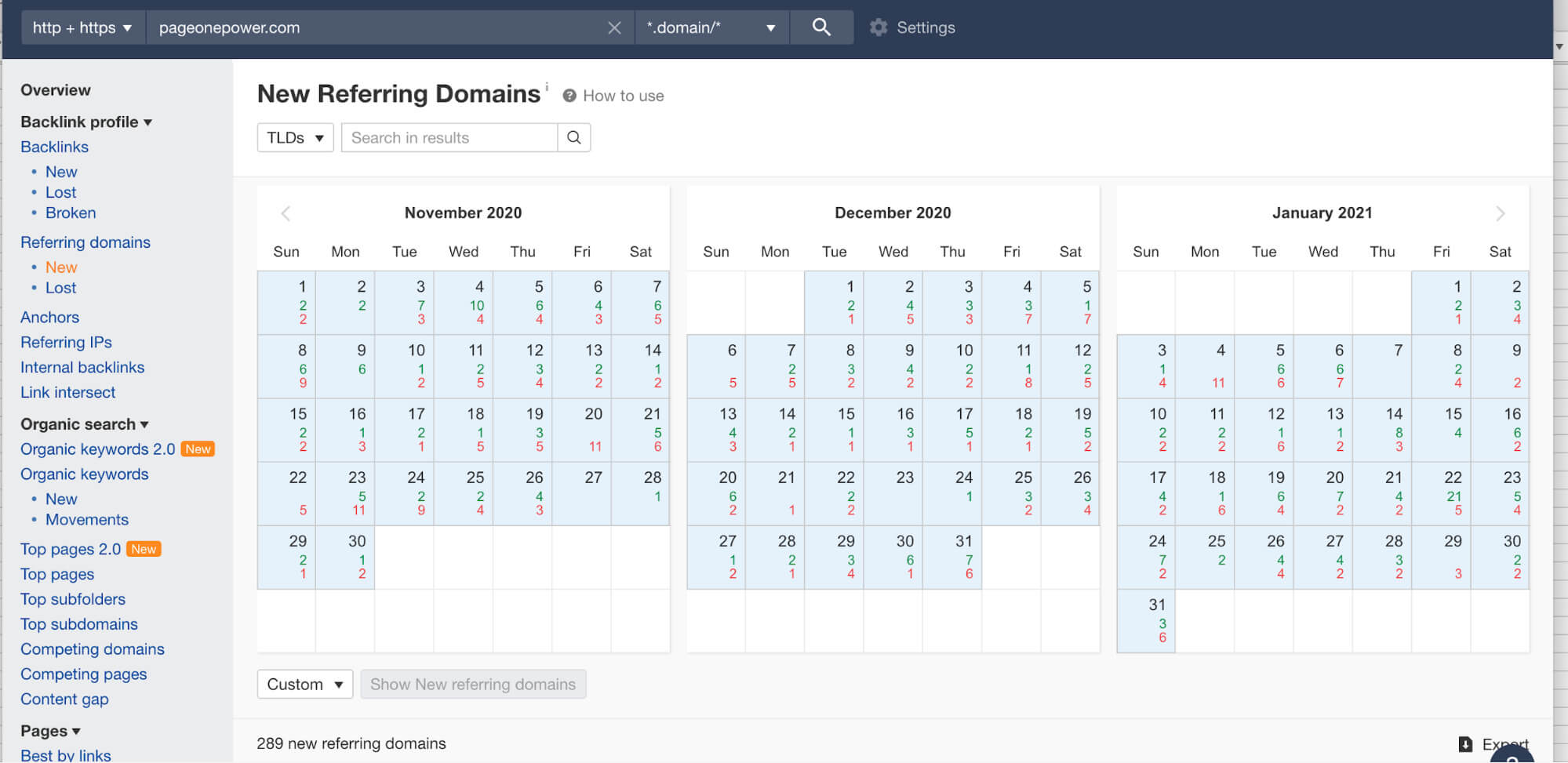
Then the formula is simple—you get the general number of links, divide it by the number of months you’ve selected, and you get your link velocity. In the example above, our competitors have built 289 links in 3 months. Hence, their link velocity is 96.
Once you’ve calculated your competitor’s link velocity, you’ll need to calculate yours. If you have a lower number than your competition you have work to do.
How to close the link gap in the most efficient way
I’m not going to sugar-coat it—closing the backlink gap is not something you can do once and cross off your todo list. It’s an always evolving process that requires constant attention.
Here are a few effective strategies that can make your link building routine easier that I’ve used at my own link building agency.
1) Always focus on the quality of links
Even if you’re a relatively new SEO, you’ve likely heard about the importance of ‘quality links.’ And it may be tempting to nod your head and say “I know!” Yet, you’d be surprised at how many marketers ignore this critical component of an effective link building strategy.
The question is, which factors determine the quality of links? I’d recommend considering the following ones:
- The website’s DR should be higher than 50. But if it’s an influencer’s blog and the DR is only 30, this site can still be considered trustworthy enough for link building
- The historical growth of referring domains should be a slow rise not a massive spike. Here’s a graph from SEMrush do give you an idea of how a progressive growth looks like:
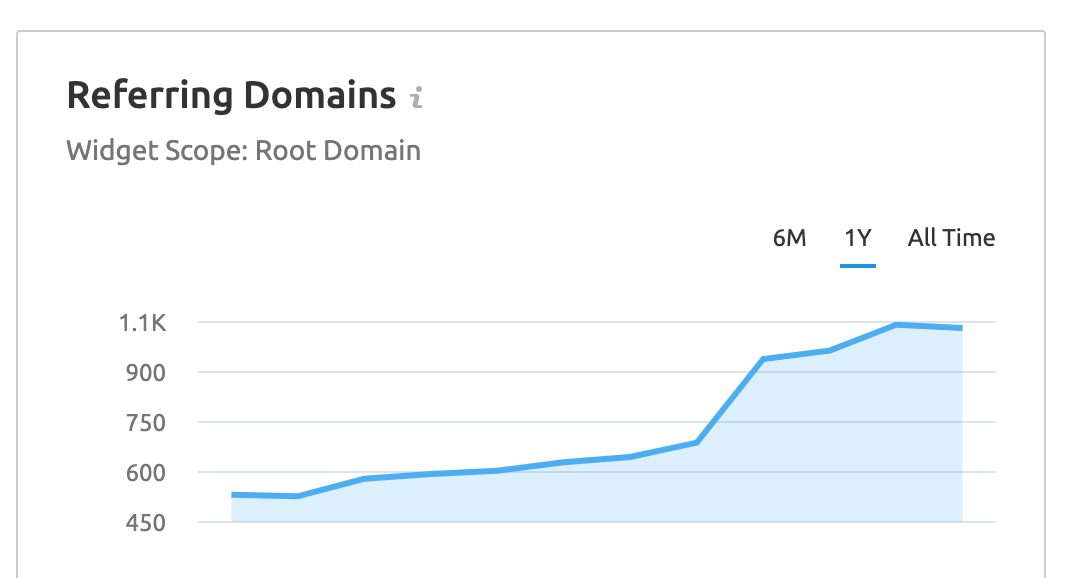
- The referring domains that a website has should be related to its niche. Majestic can be of great help here as it analyzes page titles of all referring domains of a website and makes it easier to identify the relevant ones. You can also scan the list of referring domains manually if you know your industry well enough.

- The sites with a high DR and but low number of referring domains aren’t as trustworthy.
- Generally speaking, a linking website should have a blog with a history of publishing high quality content.
All these metrics show whether a website you’re analyzing is following a shifty link building strategy or not. Any suspicious spikes in the growth of referring domains or a lot of irrelevant backlinks are a reliable indication as to whether or not a link is quality.
2) Experiment with building links on SaaS websites
In my experience, I’ve noticed that SaaS brands are often a great place to start with link acquisition. Many SaaS websites often show strong DR growth dynamics as well. Theoretically, if you build a link on a website with DR 30, this metric has all the chances to reach 60-70 very soon.
However, when it comes to link building, caution is the parent of safety. Again, before you get involved with a SaaS brand and jump right into building links, always check the historical growth of its referring domains:
If this metric shows smooth link acquisition without abrupt spikes—it’s a good sign you can proceed with little risk.
I would recommend starting your link prospecting by checking various products featured on G2, Capterra, ProductHunt, and so on. I’ve also found great success by scanning private groups on Facebook related to SaaS products. For instance, here’s a link to the group that has over 13k members:

The next step is to find marketers from tools that are relevant to your niche and connect with them via LinkedIn. I traditionally recommend against using Facebook for outreach as it can be perceived as spammy.
I wrote a previous article here on CXL that covers the most effective link building outreach strategies.
3) Prioritize the pages that are rich with links
When possible, prioritize links from pages with a high quantity of relevant links over links that are just related to your niche.
You can find such pages in Ahrefs’ Best by Links report. Ideally, if you get a link from such a page, this link’s value will jump through the roof.
Of course, many high DR websites are pitched daily, so it’s not always easy to build a link building relationship. Instead, you can switch your focus on the pages that are currently attracting a lot of links. This can be done through the Best by Links’ Growth report in Ahrefs:
Additionally, you can use LinkResearchTools to spot such pages as well. They have the LTV metric that shows the link growth to a particular page or domain in general:
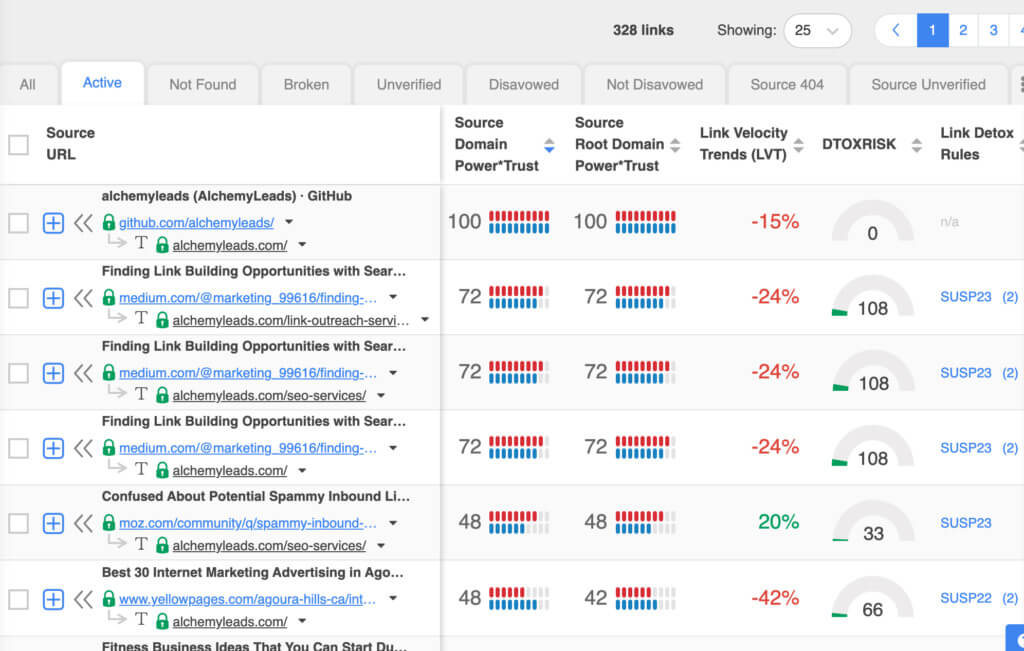
Essentially, these pages show a good link building potential and will soon become rich with links. If you take advantage of them, you’ll have a high-quality link in your profile over time.
4) Seek out the industry professionals who write guest posts
One more way to build top-notch links is through guest posts. While not as valuable as they once were, they are still an excellent method to get links though somewhat time consuming.
I recommend finding someone from your niche who has submitted guest content on industry-relevant websites and pitching a collaboration.
You can find such industry professionals through BuzzSumo—just take a couple sites with guest posts, run them through the BuzzSumo search, and it will show all the authors who have submitted content there:

Next, click on the author’s name, and BuzzSumo will show their content portfolio.
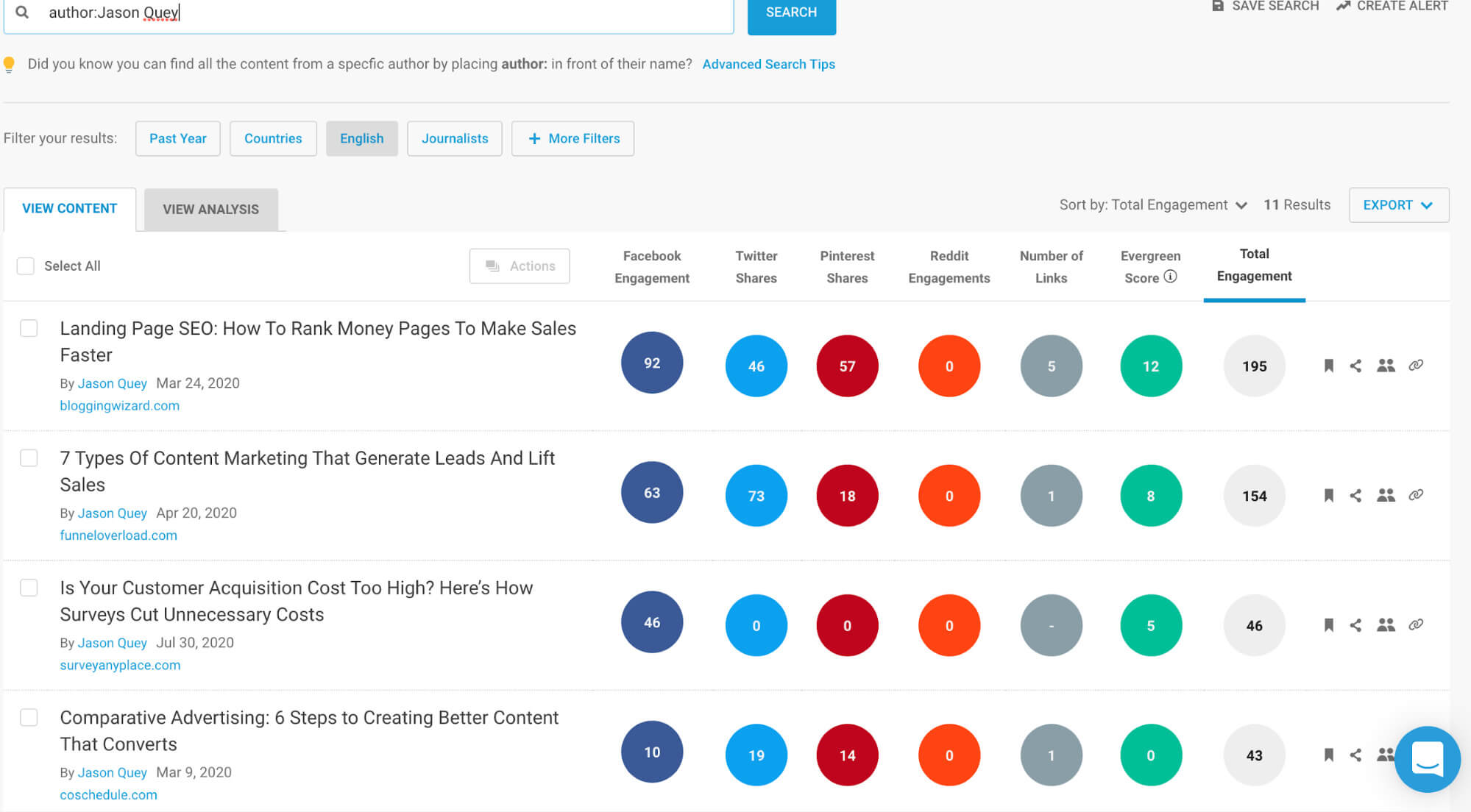
Your task here is to get the contacts of at least 15 writers. If just starting out, don’t pitch high level marketing celebrities right off the bat.
Once you’ve finalized your list of attainable folks to outreach, you can begin building the relationship. Here’s an example of an outreach email with a partnership offer:
At this point, keep in mind that you will also have to return the favor. And, if you don’t write guest posts yourself, you will have to allocate the backlink to those folks on your website which may not always be ideal.
In this case, the best solution is to write a guest post yourself or hire someone to do it for you and place the reciprocal link there. If you write at least 2-3 guest posts, you can include about 10-20 links in them. However, be sure to make that decision based on the number of reciprocal links your partners expect from you.
5) Outreach through email and social media is still effective
Of course, email outreach is also a common practice in link building. Its perk is not only building partnerships but also developing long-lasting relationships.
Traditionally, this strategy is most effective when you send a high volume of emails. Keep these things in mind.
- Personalization is a must. And no, adding a name is not enough. Try to diversify your emails by mentioning the previous company where the person worked, their last publication, tweet, etc. Most of us can spot insincere flattery a mile away. But when done right, it can be a great hook to get you in the door. In the example below, we used Pitchbox merge fields to identify the right personalization hook for the email—the country where the addressee lives.
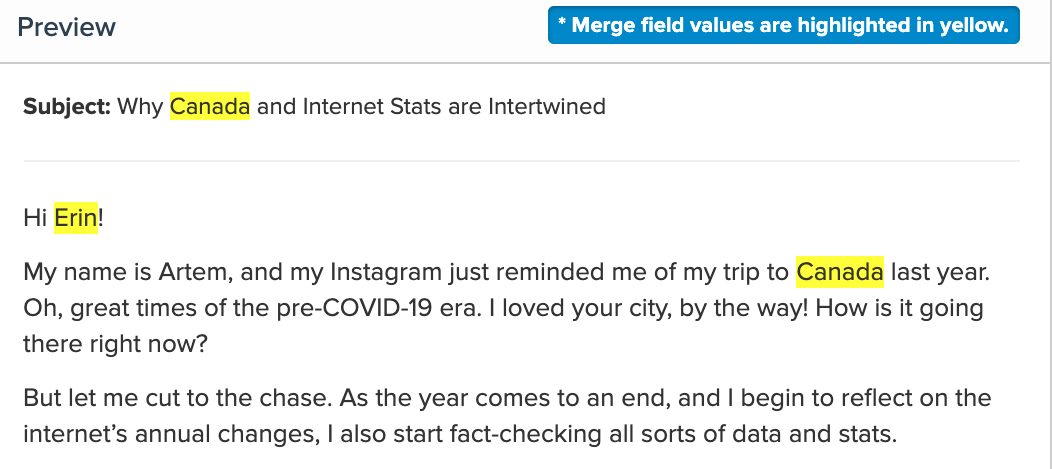
- Provide a reason for a link building partnership. Here the goal is to demonstrate what’s in it for them. For example, altering them of broken links from their website or highlighting the issue with their mobile experience. You can also point out some toxic links in their backlink profile.
- Mind your reputation. Do your email outreach campaign in a way that won’t negatively impact your brand. Remain classy, provide solid reasons for a link building collaboration, and don’t beg for links if you want to build meaningful relationships with a potential partner.
There’s one final suggestion I find incredibly important—don’t start the outreach process via email if you can. Instead, try contacting a potential partner on LinkedIn. There, you can learn more about the person’s professional activity and find an interesting topic that will help break the ice.
Conclusion
Closing the link gap and maintaining high ranking compared to your competition is not a one and done process. Taking a long term approach to your link building strategy will help you build a strong foundation and continue to dominate your rivals.
Here’s what to keep in mind.
- Determine your linkgap and account for the quality of links of your competitors.
- Calculate the link velocity of both you and those you’re trying to out rank. If your link velocity is lower, there’s plenty of room for improvement.
- Link quality matters, ignore this advice at your own risk.
- Experiment with getting links from up and coming SaaS companies.
- Prioritize links from pages with a large number of quality links.
- Create link building partnerships with industry experts who are known to guest post.
- Outreach via email and social media is still quite effective.








You know what I like about CXL articles? You bring practical examples and explain them easily. Not all marketing “blogs” do that. Often its just general advice. In other words – thanks again for great content.
Hey Alex Tachalova,
For get a higher rank in blog is that to create a high quality content. You are right acquiring high quality backlinks is still one of the most effective components of successful SEO strategy but it take long time .
I know that backlink is a linkn gap which is difference in the number of referring domains that we have compare to our competition has already acquired.
Your suggestion is right if we want to out rank then we have to calculate the link velocity of both and if our linkn velocity is low then there is plenty of room for improvement. We have always outreach via email and social media is still quite effective.
thank you,
-sweety